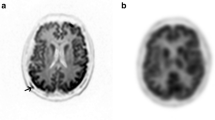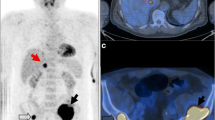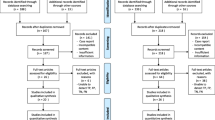Abstract
Objective
Review, qualify and synthesize the evidence that compared computed tomography (CT) images with magnetic resonance imaging (MRI) in detecting multiple myeloma (MM) lesions in the skull, through a systematic review.
Methods
Searches were performed in six databases and the grey literature, up to August 2023, without restriction by date or publication language. Observational studies comparing CT images and MRI of the skull of patients previously diagnosed with MM were included. Data were extracted by two reviewers in a standardized and independent manner. The methodological quality assessment was performed using the QUADAS-2 tool and the evidence certainty assessment using the GRADE tool.
Results
Of the 911 identified references, 11 were included, and they all used either positron emission computed tomography (PET/CT) and/or low-dose computed tomography (LDCT) to compare to MRI. In 6 of 7 studies, MRI demonstrated a greater capacity to detect MM lesions than PET/CT images. When compared with LDCT images, MRI showed lower detection capacity in 4 studies. Six of the 11 included articles had a low risk of bias. However, as observational data evidence, the assessed certainty of the evidence was considered very low.
Conclusions
PET/CT and MRI images presented limitations in detecting MM lesions in the skull compared to LDCT images. The evidence suggested that the greatest detection capability could be achieved by employing whole-body MRI complemented by LDCT images of the skull. Future studies are needed to confirm this result.

Similar content being viewed by others
Data availability
The datasets generated during and/or analyzed during the current study are available from the corresponding author upon reasonable request.
References
Terpos E, Dimopoulos MA (2005) Myeloma bone disease: pathophysiology and management. Ann Oncol 16(8):1223–1231. https://doi.org/10.1093/annonc/mdi235
Dimopoulos M, Terpos E, Comenzo RL, Tosi P, Beksac M, Sezer O et al (2009) IMWG. International myeloma working group consensus statement and guidelines regarding the current role of imaging techniques in the diagnosis and monitoring of multiple Myeloma. Leukaemia 23(9):1545–1556. https://doi.org/10.1038/leu.2009.89
Kumar SK, Rajkumar SV (2018) The multiple myelomas - current concepts in cytogenetic classification and therapy. Nat Rev Clin Oncol 15(7):409–421. https://doi.org/10.1038/s41571-018-0018-y
Owotade F, Ugboko V, Ajike S, Salawu L, Amusa Y, Omole M (2005) Head and neck manifestations of myeloma in Nigerians. Int J Oral Maxillofac Surg 34(7):761–765. https://doi.org/10.1016/j.ijom.2005.02.007
Vinayachandran D, Sankarapandian S (2013) Multiple osteolytic lesions. J Clin Imaging Sci 3(Suppl 1):6. https://doi.org/10.4103/2156-7514.117460
Collins CD. Multiple myeloma. Cancer Imaging. 2004 4 Spec No A(Spec No A):S47–53. https://doi.org/10.1102/1470-7330.2004.0010.
Treitl KM, Ricke J, Baur-Melnyk A (2022) Whole-body magnetic resonance imaging (WBMRI) versus whole-body computed tomography (WBCT) for myeloma imaging and staging. Skeletal Radiol 51(1):43–58. https://doi.org/10.1007/s00256-021-03799-4
Rajkumar SV, Dimopoulos MA, Palumbo A, Blade J, Merlini G, Mateos MV et al (2014) International Myeloma Working Group updated the criteria for the diagnosis of multiple myeloma. Lancet Oncol 15(12):e538–e548. https://doi.org/10.1016/S1470-2045(14)70442-5
Moulopoulos LA, Koutoulidis V, Hillengass J, Zamagni E, Aquerreta JD, Roche CL et al (2018) Recommendations for acquisition, interpretation and reporting of whole body low dose CT in patients with multiple myeloma and other plasma cell disorders: a report of the IMWG Bone Working Group. Blood Cancer J 8(10):95. https://doi.org/10.1038/s41408-018-0124-1
Hillengass J, Landgren O (2013) Challenges and opportunities of novel imaging techniques in monoclonal plasma cell disorders: imaging “early myeloma.” Leuk Lymphoma 54(7):1355–1363. https://doi.org/10.3109/10428194.2012.740559
Dimopoulos MA, Hillengass J, Usmani S, Zamagni E, Lentzsch S, Davies FE et al (2015) Role of magnetic resonance imaging in the management of patients with multiple myeloma: a consensus statement. J Clin Oncol 33(6):657–664. https://doi.org/10.1200/JCO.2014.57.9961
Bray TJP, Singh S, Latifoltojar A, Rajesparan K, Rahman F, Narayanan P et al (2017) Diagnostic utility of whole body Dixon MRI in multiple myeloma: A multi-reader study. PLoS ONE 12(7):e0180562. https://doi.org/10.1371/journal.pone.0180562
Ormond Filho AG, Carneiro BC, Pastore D, Silva IP, Yamashita SR, Consolo FD et al (2019) Whole-body imaging of multiple myeloma: diagnostic criteria. Radiographics 39(4):1077–1097. https://doi.org/10.1148/rg.2019180096
van Lammeren-Venema D, Regelink JC, Riphagen II, Zweegman S, Hoekstra OS, Zijlstra JM (2012) 18F-fluoro-deoxyglucose positron emission tomography in assessment of myeloma-related bone disease: a systematic review. Cancer 118(8):1971–1981. https://doi.org/10.1002/cncr.26467
Regelink JC, Minnema MC, Terpos E, Kamphuis MH, Raijmakers PG, Pieters-van den Bos IC et al (2013) Comparison of modern and conventional imaging techniques in establishing multiple myeloma-related bone disease: a systematic review. Br J Haematol 162(1):50–61. https://doi.org/10.1111/bjh.12346
Dyrberg E, Hendel HW, Al-Farra G, Balding L, Løgager VB, Madsen C et al (2017) A prospective study comparing whole-body skeletal X-ray survey with 18F-FDG-PET/CT, 18F-NaF-PET/CT and whole-body MRI in the detection of bone lesions in multiple myeloma patients. Acta Radiol Open 6(10):2058460117738809. https://doi.org/10.1177/2058460117738809
Gómez León N, Aguado Bueno B, Herreros Pérez M, León Ramírez LF, Alegre A, Colletti PM et al (2021) Agreement between 18F-FDG PET/CT and whole-body magnetic resonance compared with skeletal survey for initial staging and response at end-of-treatment evaluation of patients with multiple myeloma. Clin Nucl Med 46(4):310–322. https://doi.org/10.1097/RLU.0000000000003512
Minarik J, Krhovska P, Hrbek J, Pika T, Bacovsky J, Herman M et al (2016) Prospective comparison of conventional radiography, low-dose computed tomography and magnetic resonance imaging in monoclonal gammopathies. Biomed Pap Med Fac Univ Palacky Olomouc Czech Repub 160(2):305–309. https://doi.org/10.5507/bp.2015.064
Ippolito D, Giandola T, Maino C, Gandola D, Ragusi M, Bonaffini PA et al (2021) Whole body low dose computed tomography (WBLDCT) can be comparable to whole-body magnetic resonance imaging (WBMRI) in the assessment of multiple myeloma. Diagnostics (Basel) 11(5):857. https://doi.org/10.3390/diagnostics11050857
Page MJ, McKenzie JE, Bossuyt PM, Boutron I, Hoffmann TC, Mulrow CD et al (2021) The PRISMA 2020 statement: an updated guideline for reporting systematic reviews. BMJ 29(372):n71. https://doi.org/10.1136/bmj.n71
Chen J, Li C, Tian Y, Xiao Q, Deng M, Hu H et al (2019) Comparison of whole-body DWI and 18F-FDG PET/CT for detecting intramedullary and extramedullary lesions in multiple myeloma. AJR Am J Roentgenol 213(3):514–523. https://doi.org/10.2214/AJR.18.20989
Derlin T, Peldschus K, Münster S, Bannas P, Herrmann J, Stübig T et al (2013) Comparative diagnostic performance of 18F-FDG PET/CT versus whole-body MRI for determination of remission status in multiple myeloma after stem cell transplantation. Eur Radiol 23(2):570–578. https://doi.org/10.1007/s00330-012-2600-5
Mesguich C, Hulin C, Latrabe V, Lascaux A, Bordenave L, Hindié E et al (2020) Prospective comparison of 18-FDG PET/CT and whole-body diffusion-weighted MRI in the assessment of multiple myeloma. Ann Hematol 99(12):2869–2880. https://doi.org/10.1007/s00277-020-04265-2
Gleeson TG, Moriarty J, Shortt CP, Gleeson JP, Fitzpatrick P, Byrne B et al (2009) Accuracy of whole-body low-dose multidetector CT (WBLDCT) versus skeletal survey in the detection of myelomatous lesions and correlation of disease distribution with whole-body MRI (WBMRI). Skeletal Radiol 38(3):225–236. https://doi.org/10.1007/s00256-008-0607-4
Lai AYT, Riddell A, Barwick T, Boyd K, Rockall A, Kaiser M et al (2020) Interobserver agreement of whole-body magnetic resonance imaging is superior to whole-body computed tomography for assessing disease burden in patients with multiple myeloma. Eur Radiol 30(1):320–327. https://doi.org/10.1007/s00330-019-06281-x
Messiou C, Porta N, Sharma B, Levine D, Koh DM, Boyd K et al (2021) Prospective evaluation of whole-body MRI versus FDG PET/CT for lesion detection in participants with myeloma. Radiol Imaging Cancer 3(5):e210048. https://doi.org/10.1148/rycan.2021210048
Withofs N, Beguin Y, Cousin F et al (2019) Dual-tracer PET/CT scan after injection of combined [18F]NaF and [18F]FDG outperforms MRI in the detection of myeloma lesions. Hematol Oncol 37:193–201. https://doi.org/10.1002/hon.2600
Shortt CP, Gleeson TG, Breen KA, McHugh J, O’Connell MJ, O’Gorman PJ, Eustace SJ (2009) Whole-body MRI versus PET in assessment of multiple myeloma disease activity. AJR Am J Roentgenol 192(4):980–986. https://doi.org/10.2214/AJR.08.1633
Cascini GL, Falcone C, Console D, Restuccia A, Rossi M, Parlati A et al (2013) Whole-body MRI and PET/CT in multiple myeloma patients during staging and after treatment: personal experience in a longitudinal study. Radiol Med 118(6):930–948. https://doi.org/10.1007/s11547-013-0946-7
Pawlyn C, Fowkes L, Otero S, Jones JR, Boyd KD, Davies FE et al (2016) Whole-body diffusion-weighted MRI: a new gold standard for assessing disease burden in patients with multiple myeloma? Leukaemia 30(6):1446–1448. https://doi.org/10.1038/leu.2015.338
Giles SL, deSouza NM, Collins DJ, Morgan VA, West S, Davies FE et al (2015) Assessing myeloma bone disease with whole-body diffusion-weighted imaging: comparison with x-ray skeletal survey by region and relationship with laboratory estimates of disease burden. Clin Radiol 70(6):614–621. https://doi.org/10.1016/j.crad.2015.02.013
Gomez CK, Schiffman SR, Bhatt AA (2018) Radiological review of skull lesions. Insights Imaging 9(5):857–882. https://doi.org/10.1007/s13244-018-0643-0
Yeretsian RA, Blodgett TM, Branstetter BF 4th, Roberts MM, Meltzer CC (2003) Teflon-induced granuloma: a false-positive finding with PET resolved with combined PET and CT. AJNR Am J Neuroradiol 24(6):1164–1166
Blodgett TM, Casagranda B, Townsend DW, Meltzer CC (2005) Issues, controversies, and clinical utility of combined PET/CT imaging: what is the interpreting physician facing? AJR Am J Roentgenol 184(5 Suppl):S138–S145. https://doi.org/10.2214/ajr.184.5_supplement.0184s138
Fonti R, Salvatore B, Quarantelli M, Sirignano C, Segreto S, Petruzziello F et al (2008) 18F-FDG PET/CT, 99mTc-MIBI, and MRI in evaluation of patients with multiple myeloma. J Nucl Med 49(2):195–200. https://doi.org/10.2967/jnumed.107.045641
Walker R, Barlogie B, Haessler J, Tricot G, Anaissie E, Shaughnessy JD Jr et al (2007) Magnetic resonance imaging in multiple myeloma: diagnostic and clinical implications. J Clin Oncol 25(9):1121–1128. https://doi.org/10.1200/JCO.2006.08.5803
Padhani AR, Koh DM, Collins DJ (2011) Whole-body diffusion-weighted MR imaging in cancer: current status and research directions. Radiology 261(3):700–718. https://doi.org/10.1148/radiol.11110474
Usmani SZ, Mitchell A, Waheed S, Crowley J, Hoering A, Petty N et al (2013) Prognostic implications of serial 18-fluoro-deoxyglucose emission tomography in multiple myeloma treated with total therapy 3. Blood 121(10):1819–1823. https://doi.org/10.1182/blood-2012-08-451690
Kobe C, Dietlein M, Franklin J, Markova J, Lohri A, Amthauer H et al (2008) Positron emission tomography has a high negative predictive value for progression or early relapse for patients with residual disease after first-line chemotherapy in advanced-stage Hodgkin lymphoma. Blood 112(10):3989–3994. https://doi.org/10.1182/blood-2008-06-155820
Kwee TC, Basu S, Saboury B, Ambrosini V, Torigian DA, Alavi A (2011) A new dimension of FDG-PET interpretation: assessment of tumor biology. Eur J Nucl Med Mol Imaging 38(6):1158–1170. https://doi.org/10.1007/s00259-010-1713-9
Kamper L, Haage P, Brandt AS, Piroth W, Abanador-Kamper N, Roth S et al (2015) Diffusion-weighted MRI in the follow-up of chronic periarteritis. Br J Radiol 88(1052):20150145. https://doi.org/10.1259/bjr.20150145
Mosebach J, Thierjung H, Schlemmer HP, Delorme S (2019) Multiple myeloma guidelines and their recent updates: implications for imaging. Rofo 191(11):998–1009. https://doi.org/10.1055/a-0897-3966
Di Giuliano F, Picchi E, Muto M, Calcagni A, Ferrazzoli V, Da Ros V et al (2020) Radiological imaging in multiple myeloma: a review of the state-of-the-art. Neuroradiology 62(8):905–923. https://doi.org/10.1007/s00234-020-02417-9
Zamagni E, Tacchetti P, Cavo M (2019) Imaging in multiple myeloma: How? When? Blood 133(7):644–651. https://doi.org/10.1182/blood-2018-08-825356
Scarfe WC, Farman AG, Sukovic P (2006) Clinical applications of cone-beam computed tomography in dental practice. J Can Dent Assoc 72(1):75–80
Hildenbrand N, Klein A, Maier-Hein K, Wennmann M, Delorme S, Goldschmidt H et al (2023) Identification of focal lesion characteristics in MRI which indicate presence of corresponding osteolytic lesion in CT in patients with multiple myeloma. Bone 22:116857. https://doi.org/10.1016/j.bone.2023.116857
Acknowledgements
The authors like to thank Rodrigo Rocha for formatting the tables and Cristina Messiou, Dow-Mu Koh, Cesare Maino, and Jiri Minarik who kindly responded to all contacts.
Funding
MAV received funding from the Meu jovem cientista/Fundação de Amparo à Pesquisa do Estado do Rio de Janeiro—FAPERJ—E-26/200.299/2023 (283749). The author(s) confirm(s) independence from the sponsors; the sponsors have not influenced the article's content.
Author information
Authors and Affiliations
Contributions
All authors contributed to the study’s conception and design. Thaiza Gonçalves Rocha, Carla Barros de Oliveira, Marcela Magno, Lucianne Cople Maia, Davi Barbirato and Maria Augusta Visconti contributed to the study’s conception and design. Screening and selection of the articles were performed independently by Thaiza Gonçalves Rocha and Carla Barros de Oliveira. Data analysis was performed by Thaiza Gonçalves Rocha and Carla Barros de Oliveira. The first draft of the manuscript was written by Thaiza Gonçalves Rocha, and all authors commented on previous versions of the manuscript. All authors read and approved the final manuscript.
Corresponding author
Ethics declarations
Conflict of interest
The authors Thaiza Goncalves Rocha, Carla Barros de Oliveira, Roberto José Pessoa de Magalhães Filho, Angelo Maiolino, Marcela Baraúna Magno, Davi da Silva Barbirato, Eduardo Murad Villoria, Lucianne Cople Maia, Sandra Regina Torres; Maria Augusta Visconti declare no Conflict of interest and have no relevant financial or non-financial interests to disclose.
Ethical approval
This article does not contain any studies with human or animal subjects performed by any of the authors. This is a review; no ethical approval is required.
Additional information
Publisher's Note
Springer Nature remains neutral with regard to jurisdictional claims in published maps and institutional affiliations.
Supplementary Information
Below is the link to the electronic supplementary material.
Rights and permissions
Springer Nature or its licensor (e.g. a society or other partner) holds exclusive rights to this article under a publishing agreement with the author(s) or other rightsholder(s); author self-archiving of the accepted manuscript version of this article is solely governed by the terms of such publishing agreement and applicable law.
About this article
Cite this article
Rocha, T.G., de Oliveira, C.B., de Magalhães Filho, R.J.P. et al. Comparison between computed tomography and magnetic resonance imaging in detecting multiple myeloma lesions in the skull: A systematic review. Clin Transl Imaging 12, 177–185 (2024). https://doi.org/10.1007/s40336-023-00605-0
Received:
Accepted:
Published:
Issue Date:
DOI: https://doi.org/10.1007/s40336-023-00605-0




